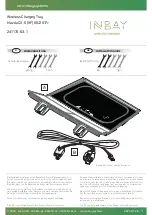
Switching on/off
X
Turn the key to position 0 in the ignition
lock or remove it (
Y
page 157).
X
To activate: press the
Ì
button.
The indicator lamp in the
Ì
button lights
up.
X
To deactivate: press the
Ì
button.
The indicator lamp in the
Ì
button goes
out.
i
Residual heat is deactivated automati-
cally:
R
after approximately 30 minutes
R
when the ignition is switched on
R
if the battery voltage drops
R
when the auxiliary heating is switched on
Auxiliary heating
Important safety notes
G
DANGER
If the exhaust pipe is blocked or sufficient
ventilation is not possible, toxic exhaust
fumes can enter the vehicle, especially car-
bon monoxide. This is the case, e.g. in
enclosed spaces, or if the vehicle is stuck in
snow. There is a risk of fatal injuries.
You should switch off the auxiliary heating in
enclosed spaces which do not have an extrac-
tion system, e.g. a garage. If the vehicle is
stuck in snow and you must leave the auxiliary
heating running, keep the exhaust pipe and
the area around the vehicle clear of snow. To
guarantee a sufficient supply of fresh air, open
a window on the side of the vehicle away from
the wind.
G
WARNING
When the auxiliary heating is switched on,
parts of the vehicle can become very hot.
Flammable materials such as leaves, grass or
twigs may ignite if they come into contact
with:
R
hot parts of the exhaust system
R
the exhaust gas itself
There is a risk of fire.
When the auxiliary heating is switched on,
make sure that:
R
no flammable materials come into contact
with hot vehicle components
R
the exhaust gas can escape from the
exhaust pipe unhindered
R
the exhaust gas does not come into contact
with flammable materials.
The auxiliary heating and the exhaust gas out-
let are situated in front of the right-hand front
wheel.
!
Operating the auxiliary heating/ventila-
tion draws on the vehicle battery. After you
have heated or ventilated the vehicle a
maximum of two times, drive for a longer
distance.
Switch the auxiliary heating on regularly once
a month for about ten minutes.
The auxiliary heating timer function calcu-
lates the switch-on time according to the out-
side temperature so that the vehicle is pre-
heated by the departure time. When the
departure time is reached, the auxiliary heat-
ing continues to heat for a further five
minutes and then switches off.
The auxiliary heating heats the air in the vehi-
cle interior to the set temperature. This
occurs without using the heat of the running
engine. The auxiliary heating is operated
directly using the vehicle's fuel. For this rea-
son, the fuel tank must be at least
Õ
full to
ensure that the auxiliary heating functions.
The auxiliary heating/ventilation automati-
cally adjusts to changes in temperature and
weather conditions. For this reason, the aux-
iliary heating could switch from ventilation
mode to heating mode or from heating mode
to ventilation mode.
148
Operating the climate control system
Climate
control
















































